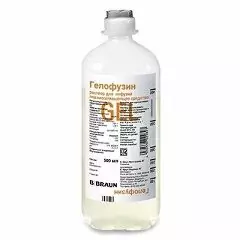- Author Rachel Wainwright [email protected].
- Public 2023-12-15 07:39.
- Last modified 2025-11-02 20:14.
Gelofusin
Gelofusin: instructions for use and reviews
- 1. Release form and composition
- 2. Pharmacological properties
- 3. Indications for use
- 4. Contraindications
- 5. Method of application and dosage
- 6. Side effects
- 7. Overdose
- 8. Special instructions
- 9. Application during pregnancy and lactation
- 10. In case of impaired renal function
- 11. For violations of liver function
- 12. Use in the elderly
- 13. Drug interactions
- 14. Analogs
- 15. Terms and conditions of storage
- 16. Terms of dispensing from pharmacies
- 17. Reviews
- 18. Price in pharmacies
Latin name: Gelofusin
ATX code: B05AA06
Active ingredient: gelatin + sodium chloride (gelatin + sodium chloride)
Manufacturer: B. Braun Melsungen, AG (Germany)
Description and photo update: 2019-26-08
Prices in pharmacies: from 2178 rubles.
Buy

Gelofusin is a drug used to replace a lack of intravascular fluid volume associated with plasma or blood loss.
Release form and composition
The dosage form of Gelofuzin is a solution for infusion: transparent, from yellow to pale yellow (in 500 ml low density polyethylene bottles, 10 bottles in a cardboard box).
Active substances in 1 ml of solution:
- succinylated gelatin (with an average molecular weight of Mn 23,200 daltons) - 40 mg;
- sodium chloride - 7.01 mg.
Auxiliary components: sodium hydroxide - 1.36 mg, water for injection - up to 1 ml.
Electrolyte concentration and physical and chemical characteristics:
- chlorides - 120 mmol / l;
- sodium - 154 mmol / l;
- pH - 7.1-7.7;
- theoretical osmolarity - 274 mOsm / l.
Pharmacological properties
Pharmacodynamics
Gelofusin is a 4% solution of succinylated gelatin (also called modified liquid gelatin). It is intended for intravenous administration and has the following physicochemical characteristics: average molecular weight - 23,200 daltons, colloidal osmotic pressure - 34 mm Hg, reaching the isoelectric point occurs at pH 4.5. The negative charges that the molecule acquires in the process of succinylation cause its increase in size. This leads to the formation of more bulky protein chains than unsuccinylated ones, but the molecular weight remains the same. As a result, Gelofuzin is characterized by a sufficient volemic effect, which manifests itself within 3-4 hours after administration.
The drug allows to eliminate the deficit in the volume of intravascular fluid associated with plasma or blood loss, and serves as its substitute. The result is an increase in mean arterial pressure, left ventricular diastolic pressure, cardiac index, as well as improved peripheral tissue perfusion and an increase in cardiac systolic volume, venous return, urine output and oxygen delivery in the body. The increase in blood pressure is not only due to the introduction of the solution, but is also associated with the additional flow of interstitial fluid into the vascular bed.
The severity of the initial effect depends on the colloidal osmotic pressure of the solution. The duration of drug action is determined by the rate of degradation and release of the colloid. The volemic effect of the drug is equivalent to the amount of solution that entered the body. Since Gelofusin is a plasma substitute, its use does not lead to an increase in plasma volume. It also prevents plasma protein loss from being replenished.
Gelofusin provokes osmotic diuresis, contributing to the maintenance of kidney function in shock, improves microcirculation and reduces blood viscosity. Colloid-osmotic properties of the drug ensure the absence or reduction of the risk of developing interstitial edema. It does not have a negative effect on the pigment, carbohydrate and protein functions of the liver and increases the ESR (erythrocyte sedimentation rate), the normalization of which is observed on average after 20 days. The volume-replacing effect lasts for 5 hours.
Pharmacokinetics
After administration, distribution occurs mainly in the intravascular space at a high speed, penetration in small amounts into the interstitial space is also likely. There is no information about cumulation in the reticuloendothelial system or in other body systems.
Gelofusin is excreted mainly in the urine (75% of the administered dose) and only in small amounts with feces (15% of the administered dose). It is metabolized by no more than 1% and quickly leaves the bloodstream, which is associated with the presence of low molecular weight fractions in large quantities (after 2 hours, about 20% of the injected gelatin is determined in the blood). Small molecules are eliminated directly by glomerular filtration, while larger molecules are first converted by proteolytic degradation in the liver and then also excreted in the urine. The adaptation of proteolytic metabolism is so easy that even in patients with renal insufficiency, there is no accumulation of gelatin. After administration as a plasma substitute, the half-life of the drug from the intravascular space is 4-5 hours. In patients on hemodialysis (glomerular filtration rate is less than 0.5 ml / min), the half-life may increase.
Indications for use
According to the instructions, Gelofusin is prescribed as a colloidal plasma-substituting agent in the following cases:
- hypotension associated, for example, with spinal / epidural anesthesia (prophylaxis);
- absolute and relative hypovolemia associated, for example, with hemorrhagic / traumatic shock, perioperative blood loss, burns, sepsis (treatment and prevention);
- extracorporeal circulation (hemodialysis, heart-lung machine);
- hemodilution.
Contraindications
Absolute:
- serious bleeding disorders;
- hypervolemia;
- severe heart failure;
- overhydration;
- individual intolerance to the components of the drug.
Relative (diseases / conditions in which Gelofusin solution should be used with caution):
- hypernatremia (due to the additional administration of sodium ions);
- dehydration (in this condition, first of all, it is necessary to correct the water-electrolyte balance);
- diseases associated with disorders of the coagulation system (administration of the drug can lead to dilution of blood coagulation factors);
- renal failure (due to the likelihood of disrupting the usual route of excretion);
- liver disease in the chronic course, in which the synthesis of albumin and coagulation factors is impaired (the introduction of Gelofusin may lead to their further dilution);
- pregnancy and lactation (use is possible only in cases where the expected benefit from taking the drug is higher than the possible harm).
Instructions for the use of Gelofuzin: method and dosage
The method of administration of the Gelofuzin solution is intravenous.
The total dose, duration and rate of administration of the drug are determined individually, taking into account the needs and results of monitoring the usual parameters of blood circulation (for example, blood pressure), which should be adjusted if necessary.
The first 20-30 ml of Gelofusin solution should be injected slowly and under close supervision in order to timely identify allergic (anaphylactic / anaphylactoid) reactions.
In case of blood clotting disorders, renal failure and chronic liver diseases, it is recommended to select a dosage regimen in accordance with the individual clinical situation, while taking into account the results of clinical and chemical studies.
The size of the maximum daily dose is determined by the degree of hemodilution achieved. When the hematocrit falls below 25% (in patients with cardiovascular and pulmonary insufficiency, this figure is 30%), transfusion of whole blood or erythrocyte mass is required, then the continuation of Gelofusin administration is possible. If necessary, subject to the above conditions, with massive blood loss, it is possible to transfuse up to 10-15 liters of solution per day.
The maximum infusion rate is determined by the state of hemodynamics, diuresis and peripheral microcirculation.
Recommended dosing regimen for adults:
- mild hypovolemia (for example, with moderate plasma and blood loss), prevention of hypovolemia and hypotension: 500-1000 ml;
- severe hypovolemia: 1000-2000 ml;
- emergency, life-threatening situations: 500 ml in the form of a rapid infusion (under pressure), then, after improving the blood circulation parameters, the infusion is carried out in an amount equivalent to a volume deficit;
- extracorporeal circulation: 500-1500 ml (depends on the used circulatory system).
Side effects
When using Gelofuzin, allergic (anaphylactic or anaphylactoid) reactions may develop, which manifest themselves in the form of skin rashes (urticaria, redness in the neck and face). In rare cases, the following side effects may occur: shock, a sharp drop in blood pressure, cardiac arrest and respiratory arrest. In such cases, the infusion is stopped immediately.
Allergic reactions can be histamine-independent and histamine-mediated. The release of histamine can be prevented by using a combination of H 1 and H 2 receptor blockers. The effectiveness of prophylactic use of corticosteroids has not been proven.
Adverse reactions can develop in patients with / without consciousness. In the acute phase of shock, which is caused by volumetric insufficiency, cases of the development of allergic reactions have not been registered.
Overdose
The introduction of Gelofusin in large quantities may increase the risk of circulatory overload. When undesirable symptoms appear, the administration of the drug is immediately stopped and, if necessary, diuretics are prescribed.
special instructions
Gelofusin can affect clinical and chemical parameters. The following laboratory results may be higher than expected: urine specific gravity, erythrocyte sedimentation rate, and urine protein levels.
It is necessary to control the body's water balance and the serum ionogram. This is especially important in hypernatremia, renal failure and dehydration conditions.
In chronic liver diseases and blood clotting disorders, it is necessary to monitor the parameters of serum albumin and blood clotting.
Due to the possibility of allergic reactions, the condition of patients must be carefully monitored.
When using Gelofusin in the form of an infusion under pressure (infusion pump, tonometer cuff), the solution must be warmed up to body temperature, all air must be removed from the bottle beforehand.
Influence on the ability to drive vehicles and complex mechanisms
It is not known how the use of Gelofusin affects the ability to drive vehicles and engage in potentially hazardous activities that require an increased concentration of attention and immediate reactions.
Application during pregnancy and lactation
There are no data on any embryotoxic effects of Gelofusin, but since it is impossible to completely eliminate the risk of allergic (anaphylactoid / anaphylactic) reactions, the drug should be used only as directed by a doctor and provided that the expected benefit exceeds the expected risk.
There is no information about the possibility of penetration of the drug into breast milk, therefore, the doctor decides on the appointment of Gelofusin during breastfeeding, provided that the expected benefit exceeds the expected risk.
With impaired renal function
In case of impaired renal function, the drug must be taken with caution.
For violations of liver function
In the presence of chronic liver disease, Gelofusin should be taken with caution.
Use in the elderly
In elderly patients, the degree of decrease in hematocrit after administration of the drug should not exceed 25%.
Drug interactions
Gelofusin compatibility / incompatibility data:
- incompatibility: fat emulsions, barbiturates, muscle relaxants, antibiotics, glucocorticosteroids;
- compatibility: solutions of electrolytes, carbohydrates, whole blood.
Analogs
Analogs of Gelofuzin are: Gelatinol, Albumin, Polyglukin, Voluven, Geloplasma balance, Refortan, Gemodez, Venofundin, etc.
Terms and conditions of storage
Store without freezing at temperatures up to 25 ° C. Keep out of the reach of children.
The shelf life is 3 years.
Terms of dispensing from pharmacies
For hospitals.
Reviews about Gelofusin
Reviews of Gelofusin indicate that it should be used with significant blood loss, since it is characterized by minimal hemostasiological effects. Its advantages include pronounced volemic activity and the absence of a negative effect on the function of the kidneys and liver, as well as hemostasis. In addition, it has a significant detoxifying effect, and its use practically does not lead to the development of allergic reactions (however, in some cases, they are observed).
There are statements that the use of Gelofusin more effectively improves microcirculation in comparison with preparations containing hydroxyethyl starch. Therefore, it is recommended to use it for massive bleeding and in emergency situations. However, reviews of the drug are few, since not all patients are aware of which infusion therapy agents were administered to them in the postoperative period in the intensive care unit. Gelofusin is often administered in large quantities - up to 7 liters.
Price for Gelofusin in pharmacies
The approximate price of Gelofuzin in pharmacy chains is 2,145-2400 rubles (the package includes 10 bottles of 500 ml).
Gelofusin: prices in online pharmacies
|
Drug name Price Pharmacy |
|
Gelofusin 4% solution for infusion 500 ml 10 pcs. RUB 2178 Buy |

Maria Kulkes Medical journalist About the author
Education: First Moscow State Medical University named after I. M. Sechenov, specialty "General Medicine".
Information about the drug is generalized, provided for informational purposes only and does not replace the official instructions. Self-medication is hazardous to health!






